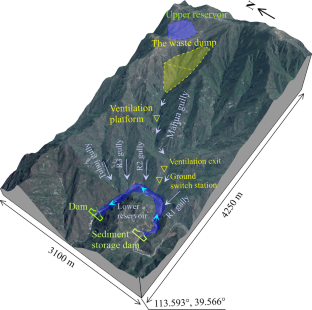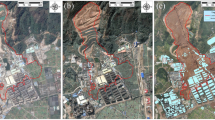Abstract
Engineering construction (such as water conservancy project, road engineering, and so on) in mountain areas bring mass of waste soil and rock fragment, whose stability is critical to the ecological environment and the safe operation of engineering facilities. The biggest waste dump of the Pumped Storage Power Station Project in Hunyuan County, Shanxi Province, China, with a volume of 7 million m³ and a maximum height of 240 m, is to be located at the origin of Mahua Valley. To assess the potential risk of the waste dump, reconnaissance, geomorphological analysis was undertaken to provide basic data. The potential failure area and volume was determined utilizing Flac3D depending on strength reduction method. The kinematic process and the potential hazards after failure was presented by Particle flow code. The results showed that the factor of safety of the waste dump under heavy precipitation was 1.15, less than the stability requirement of slope in hydropower station, and the potential failure volume was about 4.8 million m³. The scenario-based debris mass run-out paths indicated that, considering the worst cases scenario, the ground ventilation platform and ventilation tunnel exit on the right bank of the gully might be destroyed rapidly by landslide debris. Besides, the debris flow would accumulate at the gully mouth, and even run into the lower reservoir. Thus, more attention should be taken to increase the stability of the waste dump. These results are useful information for decision support and future hazard assessment of such engineering project.













Similar content being viewed by others
References
Ai J, Chen JF, Rotter JM, Jin YO (2011) Assessment of rolling resistance models in discrete element simulations. Powder Technol 206:269–282
Bao Y, Han X, Chen J, Zhang W, Zhan J, Sun X, Chen M (2019) Numerical assessment of failure potential of a large mine waste dump in Panzhihua City. China Eng Geol 253:171–183. https://doi.org/10.1016/j.enggeo.2019.03.002
Beguería S, Van Asch TWJ, Malet JP, Gröndahl S (2009) A GIS-based numerical model for simulating the kinematics of mud and debris flows over complex terrain. Nat Hazards Earth Syst Sci 9:1897–1909. https://doi.org/10.5194/nhess-9-1897-2009
Blight G (2008) Slope failures in municipal solid waste dumps and landfills: a review Waste management & research. J Int Solid Wastes Public Clean Association ISWA 26:448–463. https://doi.org/10.1177/0734242X07087975
Blight GE, Fourie AB (2005) Catastrophe revisited – disastrous flow failures of mine and municipal solid waste. Geotech Geol Eng 23:219–248. https://doi.org/10.1007/s10706-004-7067-y
Chang K, Taboada A (2009) Discrete element simulation of the Jiufengershan rock-and-soil avalanche triggered by the 1999 Chi-Chi earthquake. Taiwan J Geophys Res 114. https://doi.org/10.1029/2008JF001075
Conte E, Donato A, Troncone A (2016) A simplified method for predicting rainfall-induced mobility of. Act Landslides Landslides 14:1–11
Cundall PA, Strack ODL (1979) A discrete numerical model for granular assemblies Géotechnique. 29:47–65. https://doi.org/10.1680/geot.1979.29.1.47
De Vita P et al (1998) Rainfall-triggered landslides: a. Ref list Environ Geol 35:219–233. https://doi.org/10.1007/s002540050308
Delaney KB, Evans SG (2015) The 2000 Yigong landslide (Tibetan Plateau), rockslide-dammed lake and outburst flood: review, remote sensing analysis. Process Modelling Geomorphology 246:377–393. https://doi.org/10.1016/j.geomorph.2015.06.020
George D, Iverson R (2011) A two-phase debris-flow model that includes coupled evolution of volume fractions, granular dilatancy, and pore-fluid pressure. https://doi.org/10.4408/IJEGE.2011-03. B-047
Giani GP (1992) Rock Slope Stability Analysis. A. A. Balkema, Rotterdam, p 361
Itasca CGI (2008) PFC3D particle Flow Code in 3 dimensions. User’s Guide, Minneapolis
Iverson RM (2000) Landslide triggering by rain infiltration. Water Resour Res 36:1897–1910
Iwashita K, Oda M (1998) Rolling resistance at contacts in simulation of shear band development by DEM. J Eng Mech 124:285–292
Iwashita K, Oda M (2000) Micro-deformation mechanism of shear banding process based on modified distinct element method. Powder Technol 109:192–205. https://doi.org/10.1016/S0032-5910(99)00236-3
Kjeldsen P, Fischer E (1995) Landfill Gas Migration–Field investigations at Skellingsted Landfill, Denmark Waste Management & Research -. WASTE MANAGE RES 13:467–484. https://doi.org/10.1177/0734242X9501300506
Kocasoy G, Curi K (1995) The Ümraniye-Hekimbaşi open dump accident Waste Management & Research -. WASTE MANAGE RES 13:305–314. https://doi.org/10.1016/S0734-242X(95)90080-2
Lavigne F et al (2014) The 21 February 2005, catastrophic waste avalanche at Leuwigajah dumpsite, Bandung. Indonesia Geoenvironmental Disasters 1:10. https://doi.org/10.1186/s40677-014-0010-5
Leng Y, Peng J, Wang Q, Meng Z, Huang W (2018) A fluidized landslide occurred in the Loess Plateau: a study on loess landslide. South Jingyang Tableland Eng Geol 236:129–136. https://doi.org/10.1016/j.enggeo.2017.05.006
Liu HD, Li DD, Wang ZF (2018) Dynamic process of the Wenjiagou rock landslide in Sichuan Province. China Arab J Geosci 11:233. https://doi.org/10.1007/s12517-018-3564-9
Lo C-M, Lin M-L, Tang C-L, Hu J-C (2011) A kinematic model of the Hsiaolin landslide calibrated to the morphology of the landslide deposit. Eng Geol 123:22–39. https://doi.org/10.1016/j.enggeo.2011.07.002
Lo C-M, Huang W-K, Lin M-L (2016) Earthquake-induced deep-seated landslide and landscape evolution process at Hungtsaiping, Nantou County. Taiwan Environ Earth Sci 75:645. https://doi.org/10.1007/s12665-016-5474-z
Lu CY, Tang CL, Chan YC, Hu JC, Chi CC (2014) Forecasting landslide hazard by the 3D discrete element method: a case study of the unstable slope in the Lushan hot spring district. Cent Taiwan Eng Geol 183:14–30
Mangeney A, Roche O, Hungr O, Mangold N, Faccanoni G, Lucas A (2010) Erosion and mobility in granular collapse over sloping beds. J Geophys Res Earth Surf 115
Mcdougall S, Hungr O (2004) A model for the analysis of rapid landslide motion across three-dimensional terrain. Can Geotech J 41:1084–1097
Molinari ME, Cannata M, Meisina C (2014) r.massmov: an open-source landslide model for dynamic early warning systems. Nat Hazards 70:1153–1179. https://doi.org/10.1007/s11069-013-0867-8
O’Sullivan C (2011) Particle-based discrete element modeling. Geomech Perspective Int J Geomech 11:449–464
Oda M, Iwashita K, Kakiuchi T (1997) Importance of particle rotation. Mech Granul Mater Powders Grains 97:207–210
Ouyang C, He S, Xu Q, Luo Y, Zhang W (2013) A MacCormack-TVD finite difference method to simulate the mass flow in mountainous terrain with variable computational domain. Comput Geosci 52:1–10. https://doi.org/10.1016/j.cageo.2012.08.024
Ouyang C, He S, Tang C (2015) Numerical analysis of dynamics of debris flow over erodible beds in Wenchuan earthquake-induced area. Eng Geol 194:62–72. https://doi.org/10.1016/j.enggeo.2014.07.012
Ouyang C, Zhou K, Xu Q, Yin J, Peng D, Wang D, Li W (2017) Dynamic analysis and numerical modeling of the 2015 catastrophic landslide of the construction waste landfill at Guangming, Shenzhen. China Landslides 14:705–718. https://doi.org/10.1007/s10346-016-0764-9
Peng J, Ma P, Wang Q, Zhu X, Zhang F, Tong X, Huang W (2018) Interaction between landsliding materials and the underlying erodible bed in a loess flowslide. Eng Geol 234:38–49. https://doi.org/10.1016/j.enggeo.2018.01.001
Poisel R, Preh A (2008) 3D landslide run out modelling using the particle Flow Code PFC3D. In. 873–879. https://doi.org/10.1201/9780203885284-c110
Savage S, Hutter C (1989) The motion of a finite mass of granular material down a rough incline. J Fluid Mech 199:177–215. https://doi.org/10.1017/S0022112089000340
Scaringi G et al (2018) Some considerations on the use of numerical methods to simulate past landslides and possible new failures: the case of the recent Xinmo landslide (Sichuan, China. Landslides 15:1359–1375. https://doi.org/10.1007/s10346-018-0953-9
Xin H, Hanley KJ, O’Sullivan C, Kwok CY (2015) Exploring the influence of interparticle friction on critical state behaviour using. DEM Int J Numer Anal Methods Geomech 38:1276–1297
Xu Q, Peng D, Li W, Dong X, Hu W, Tang M, Liu F (2017) The catastrophic landfill flowslide at Hongao dumpsite on December 20, 2015 in Shenzhen. China Nat Hazards Earth Syst Sci 17:1–19
Zhou J-w, Huang K-x, Shi C, Hao M-h, Guo C-x (2015) Discrete element modeling of the mass movement and loose material supplying the gully process of a debris avalanche in the Bayi Gully. Southwest China J Asian Earth Sci 99:95–111. https://doi.org/10.1016/j.jseaes.2014.12.008
Acknowledgements
This study is supported by the National Key R & D Projects (NO. 2019YFC1509704), National Natural Science Foundation of China (NO. U1704243), Key scientific research project of colleges and universities in Henan Province (23A410002), The Project of High-level talents in North China University of Water Resource and Electric Power (NO.202010013), Postgraduate Education Reform and Quality Improvement Project of Henan Province(YJS2022JD02, YJS2022AL006).
Funding
This study is supported by the National Key R & D Projects (NO. 2019YFC1509704), National Natural Science Foundation of China (NO. U1704243), Key scientific research project of colleges and universities in Henan Province(23A410002), The Project of High-level talents in North China University of Water Resource and Electric Power (NO.202010013), Postgraduate Education Reform and Quality Improvement Project of Henan Province(YJS2022JD02、YJS2022AL006).
Author information
Authors and Affiliations
Corresponding author
Ethics declarations
Conflict of interest
No conflict of interest exits in the submission of this manuscript, and manuscript is approved by all authors for publication. I would like to declare on behalf of my co-authors that the work described was original research that has not been published previously, and not under consideration for publication elsewhere, in whole or in part. All the authors listed have approved the manuscript that is enclosed.
Additional information
Publisher’s Note
Springer Nature remains neutral with regard to jurisdictional claims in published maps and institutional affiliations.
Rights and permissions
Springer Nature or its licensor (e.g. a society or other partner) holds exclusive rights to this article under a publishing agreement with the author(s) or other rightsholder(s); author self-archiving of the accepted manuscript version of this article is solely governed by the terms of such publishing agreement and applicable law.
About this article
Cite this article
Li, Dd., Liu, Hd., Wang, Zf. et al. Potential risk assessment of the large hydropower station dumpsite using numerical simulation: a case study in Shanxi Province, China. Nat Hazards (2024). https://doi.org/10.1007/s11069-024-06505-4
Received:
Accepted:
Published:
DOI: https://doi.org/10.1007/s11069-024-06505-4




